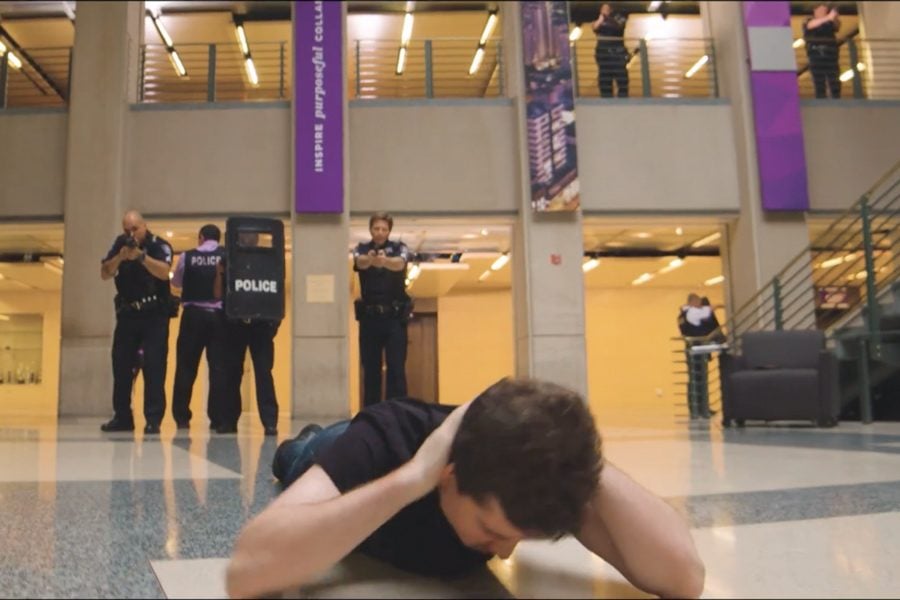Eight months after gun hoax, University releases video on emergency protocol
Source: “Run, Hide, Fight” Training Video
An actor portraying an active shooter surrenders to University Police. UP released the “Run, Hide, Fight” training video Thursday.
November 9, 2018
In a new training video released Thursday depicting an active shooter simulation, Northwestern University Police and UP Chief Bruce Lewis advised students to quickly determine whether to run, fight or hide in an emergency situation.
The video, shot on the Evanston campus, was produced based on the “Run, Hide, Fight” protocol recommended by the Department of Homeland Security. The DHS program aims to increase emergency preparedness by providing tools and resources in case of an active shooter incident.
The video was released eight months after the Evanston campus went on lockdown when a man called the Evanston Police Department claiming to have shot his girlfriend, an NU graduate student. Though the call turned out to be a hoax, students, faculty and staff on campus reported feeling terrified as they hid inside their classrooms, dorms or offices.
NU had been using a DHS video as guidance for years, said University spokesman Bob Rowley, and UP and the administration decided it was time for something new. The video was shot over the summer, and was pre-scheduled to be released on Thursday. Many students saw the video after they heard the news about a shooting at a bar in Thousand Oaks, California, that killed 12.
In an email to the NU community, UP Chief Bruce Lewis advised all students to watch the
video, and wrote that even though it could be triggering, “simulated scenarios are effective learning tools.”
Rowley added that he thought the video being shot on NU’s campus would make it more effective than if it were shot elsewhere.
“We want people be as safe as they possibly can, and this seemed like the most effective way to be realistic,” Rowley said.
And aside from the actors pausing to explain their actions, the video seeks to portray a real active-shooter situation.
In one scene, a professor and his students turn off the classroom lights, lock the door and barricade themselves inside with desks. The shooter looks in the window, jiggles the door handle and walks away.
The University used DHS guidance to make the video, but the agency’s advice has been criticized.
Chris Grollnek, a retired police officer and active shooter expert, said “hide” is the last thing to do when a shooter is on the loose.
“If you’re hiding, you’re ultimately giving the shooter the opportunity to hunt you down,” he said.
DHS still recommends hiding as its second resort to stay safe in an emergency violence situation.
Data now show that hiding isn’t just worse than running, it could be dangerous. Moving targets have only a 4 percent chance of getting shot in an active shooter situation, Grollnek said, and most fatalities during school shootings were cornered in classrooms.
“If you were in a class and I told you there was a bomb in your classroom, would you hide under your desk or would you leave?” Grollnek asked. “You would get out of there.”
However, Rowley noted sometimes hiding is the only choice.
“The video explains very carefully what each scenario is and when to do it,” Rowley said. “And that’s why we have the three options explained as they are. If you can run, you should run. If you can hide and you don’t have time to run, then you should hide.”
Weinberg sophomore Antonia Young thinks the video should have explained more clearly the dangers of hiding in an active shooter situation, and that the scene in the video doesn’t show a situation in which hiding would be ideal.
“If you’re in a room that has things such as a hole puncher or a fire extinguisher and you can fight when the shooter finds you, then I think hiding would be a reasonable response,” Young said. “But if you’re in a room like they show in the video, I would say run.”
However, Young still thinks the video did its job, especially in its choice to depict an active shooter situation on NU’s campus. The intensity of the situation was necessary to get students to pay attention, she said.
“By explaining it in a realistic way we hope people will have muscle memory,” Rowley said. “It’s an effective way to have safety training, that is our hope.”
Email: cameroncook2021@u.northwestern.edu
Twitter: @cam_e_cook



